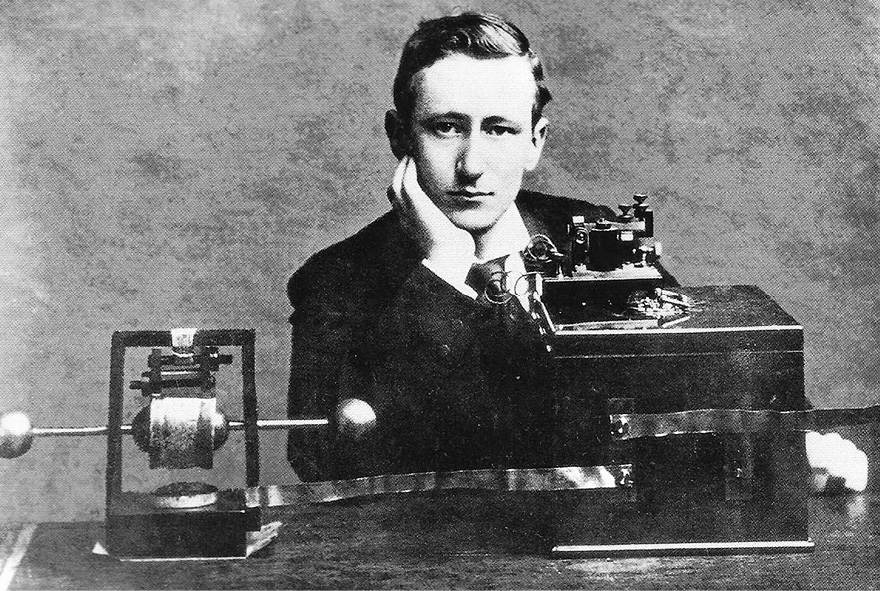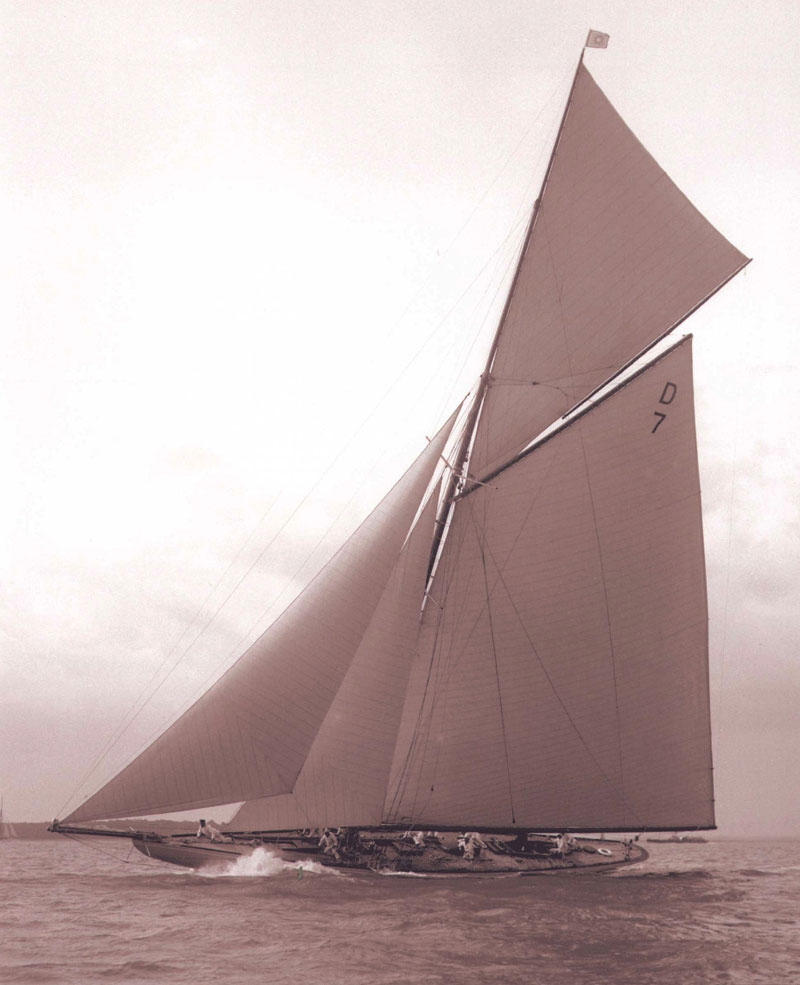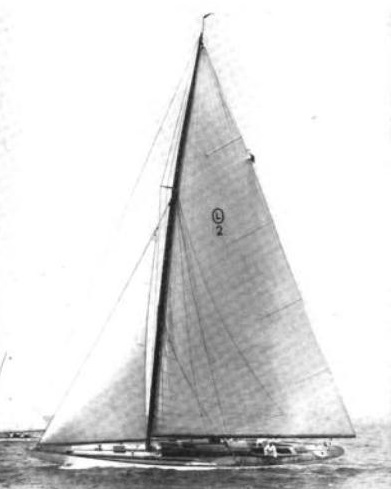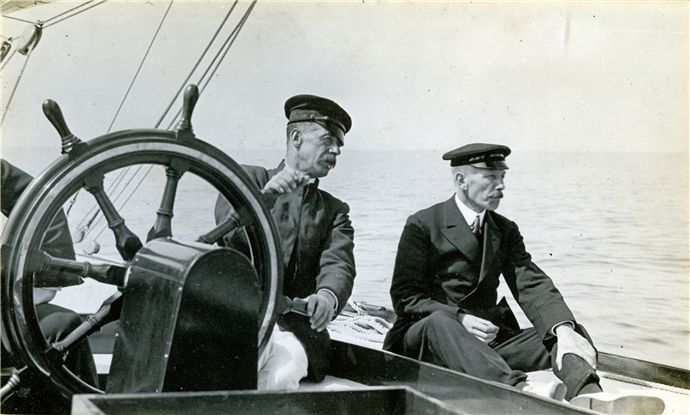Guglielmo Marconi (December 12, 1901) – “Shortly before midday I placed the single earphone to my ear and started listening. The receiver on the table before me was very crude — a few coils and condensers and a coherer — no valves, no amplifiers, not even a crystal. But I was at last on the point of putting the correctness of all my beliefs to test. The answer came at 12: 30 when I heard, faintly but distinctly, pip-pip-pip. I handed the phone to Kemp: “Can you hear anything?” I asked. “Yes,” he said. “The letter S.” He could hear it. I knew then that all my anticipations had been justified. The electric waves sent out into space from Poldhu had traversed the Atlantic — the distance, enormous as it seemed then, of 1,700 miles — unimpeded by the curvature of the earth. The result meant much more to me than the mere successful realization of an experiment. As Sir Oliver Lodge has stated, it was an epoch in history. I now felt for the first time absolutely certain that the day would come when mankind would be able to send messages without wires not only across the Atlantic but between the farthermost ends of the earth.”
Titantic 1912 – “Those who have been saved, have been saved through one man, Mr. Marconi…and his marvelous invention.” Marconi was offered free passage on Titanic before she sank, but had taken Lusitania three days earlier. As his daughter Degna later explained, he had paperwork to do and preferred the public stenographer aboard that vessel.

The evolution of the Marconi rig, unabated in invention, descendant of patent disputes, and improper adjectivization
Guglielmo Marconi was born at Bologna, Italy, on April 25, 1874, the second son of Giuseppe Marconi, an Italian country gentleman, and Annie Jameson, daughter of Andrew Jameson of Daphne Castle in the County Wexford, Ireland.
During his early years, Marconi studied the works of Maxwell, Righi, Lodge and the detailed accounts of Heinrich Hertz, who, beginning in 1888, demonstrated that one could produce and detect electromagnetic radiation—now generally known as radio waves.
In 1895 Marconi, utilizing Heinrich Hertz spark arrester, a Alexander Stepanovich Popov antenna and a Edouard Blamely coherer, succeeded in sending wireless signals over a distance of one and a half miles.
The young Marconi had taken out the first wireless telegraphy patent in England in 1896, which was grated in March of 1897. His device had only a two-circuit system, which some said could not transmit “across a pond.”

Nikola Tesla was born “at the stroke of midnight” during a summer storm and lightning on July 10, 1856 in Smiljan, Lika, which was then part of the Austo-Hungarian Empire, region of Croatia. Tesla’s interest in electrical invention was inspired by his mother, Djuka Mandic, who invented small household appliances in her spare time while her son was growing up. Tesla’s father, Milutin Tesla, was an Orthodox priest and a writer,
Nikola Tesla immigrated to the United States in 1884 to work for Thomas Edison in New York City. He soon struck out on his own with financial backers, setting up laboratories and companies to develop a range of electrical devices.
In 1891 Tesla invented the infamous Tesla Coil, an air-core resonating transformer which would become the forerunner of the radio-frequency coil and allowed the “Radio Age” to take one of it’s first formative steps.
By early 1895, Tesla was ready to transmit a signal 50 miles to West Point, New York… But in that same year, disaster struck. A building fire consumed Tesla’s lab, destroying his work.
Tesla filed his own basic American radio patent applications in 1897. They were granted in 1900.

In 1899, through the use of Tesla’s oscillators Marconi successfully transmitted across the English Channel. Later Marconi then placed an antenna and receiving station at the “Twin Lights” Navesink Light Station to demonstrate his Wireless Telegraph. The New York Herald newspaper had hired him to report on the 1899 America’s Cup yacht races which were being held off the tip of Sandy Hook, the first use of wireless telegraphy on a commercial basis.

The increased length of the transmitter and receiver antennas, increased transmitting distances significantly. Mast-like wireless antennas, with many complex standing supporting cables, a concept that was used and incorporated in 1912 on Charles Ernest Nicholson’s revolutionary 15mR ISTRIA. Her first sailing season brought great success, winning 23 out of 36 races.
William Fife’s 15-Metre LADY ANNE built in 1912 was altered in 1913 with the Jib-headed rig, but the “Great War” intervened in the 1914 season before much use could be made of her.
Until, British yacht designer, Charles E. Nicholson developed ISTRIA’s new mast, the topsail was laced to a jack-yard, which was then hoisted from the heavy solid cored topmast. The cleverness of the new mast lies wherein the topmast were hollow and were extended to the full height of a jack-yard, and the leading edge of the topsail is hoisted on a track for its full length. The main advantages of this design lay in improved sail shape.
The new rigs, were known at the time as “fish-pole” mast. These mast, with marconi-like rigging, were adaptions of the Bermuda rig, forebears of the Jamaican sloops of the 17th century.

After ISTRIA came the 1917 William Gardner designed VARUNA, the Larchmont Yacht Club’s flagship, She was built for, the Commodore of the club, James B. Ford of Rye, New York. VARUNA was the first American designed yacht fitted out with the innovative and controversial Marconi rig. VARUNA was skippered by Butler Whiting and she proved conclusively, for the first time, that the Marconi rig was the fastest. The Marconi rigs came out in force at the close of World War I, and owe their success and use to ISTRIA and Larchmont O VARUNA.
In November in the year 1920, Mr. Charles Ernest Nicholson protested against the use of the name Marconi, and suggested that it should be called the jib-header. His recommendations found and audience citing that the terminology was incorrect and meaningless. In England the term Marconi was substituted and Marconi, Bermuda or Mudian was used and remains to this day.
By the end of “Great War” and the beginning of the early 20’s many designers were embracing this new concept. The 1906 Nicholson 28-metre NYRIA, was re-rigged and fitted out with a new jib-headed mainsail. Francis Sweisguth designer of the Star class boat re-rigged the stars to the new Marconi. These great success’s paved the way, revolutionizing the rig for generations to come. “Marconi Rigs,” development of the often misused term Bermuda rig, or Bermudian rig (although non-Bermudians who are ignorant of the proper adjectivization often use Bermudan, this should be avoided as it causes offense to Bermudians.

Through the numerous patent disputes, with Tesla patent being granted in 1900, came controversy. Marconi’s first patent application in America, filed on November 10, 1900, was turned down. Marconi’s revised applications over the next three years were repeatedly rejected because of the priority of Tesla and other inventors.
Otis Pond, an engineer then working for Tesla, said, “Looks as if Marconi got the jump on you.” Tesla replied, “Marconi is a good fellow. Let him continue. He is using seventeen of my patents.”
But Tesla’s calm confidence was shattered in 1904, when the U.S. Patent Office suddenly and surprisingly reversed its previous decisions and gave Marconi a patent for the invention of radio. The reasons for this have never been fully explained, but the powerful financial backing for Marconi in the United States suggests one possible explanation.
With the collective great minds of the “Golden Age” in communication, came great invention to an unrelated industry. The enormous antenna’s with their shrouds and guys were used as inspiration and guided and changed forever the future of the sailing world. Heavy solid cored mast, would forever be a thing of the past.

Guglielmo Marconi, so adored his research ship that he named a daughter after her – Elettra – instead of the other way around. The ship, which the scientist used as home and laboratory, was destroyed in World War II, and a piece of Mr. Marconi’s history was lost with it.
References
MotorBoating Dec 1941
Motorboating – ND Jul 1937
Mocavo / Records / The Dictionary of National Biography
The 15-metre class
*Noteworthy
1800 – Washington, D.C. established as capital of US.
1911 – Delhi replaces Calcutta as the capital of India.
1914 – The largest one-day percentage drop in the history of Dow Jones Industrial Average, down 24.39%.
1925 – Arthur Heinman coins term “motel”; opens Motel Inn, San Luis Obispo.
1932 – USSR & China resume diplomatic relations.
1946 – UN accepts 6 Manhattan blocks as a gift from John D. Rockefeller Jr.
